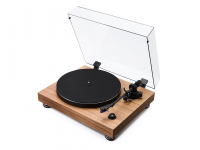After a low key but bright introduction into the hi-fi universe in the early 90’s, the Digital-to-Analogue Converter (DAC) has found its place in the modern hi-fi scene well and truly cemented in the past five or so years.
With more and more of us now relying on streaming services and our PC’s and laptops for our music playback, the DAC has taken on a life of its own, offering a handy sidestep of the low quality hardware generally packed into these non-audio devices and giving a huge boost to sound reproduction in the process. Whilst the initial relaunch of these digital wonders was mainly in the budget arena, more and more high-end manufacturers are getting in on the act of transforming your digital listening into hi-fi gold. Today we take a look at a new offering from British hi-fi royalty. Say hello to the Roksan K3 DAC!
Having already released an amplifier and CD player in the K3 range, a DAC was the next obvious step from one of Britain’s oldest audio brands. Given it’s +£1000 price point, the K3 DAC needs to offer something particularly special to show its value. Fortunately, Roksan have pulled out all the stops, and what they’ve come up with is a fantastic sounding piece of kit. But more on that later…

Probably more so than any other hi-fi component, DACs have to make a good impression with their connectivity. The K3 definitely gets off to a good start, and things are a little unusual (in a good way) in comparison to some of its competitors. The first thing most will spot is the front-mounted USB-B socket, one of the two of USB-B ports supplied and the first of the left-field design decisions. Chosen as a convenient option for those with their system tucked away on a rack but with a laptop that still performs its day-to-day duties away from the hi-fi, Roksan have definitely considered practicality when setting out their stall. The rear of the unit houses the other USB-B socket for those unable to live with a cable trailing out of the front.
Taking up the rest of the room on the rear panel are an XLR AES3 connection, an optical socket and coaxial port, too. There’s also three sets of analogue outputs – a set of XLR’s and two pairs of RCA’s, giving a convenient way of plugging between, say, a hi-fi and a home cinema system in the same room. Roksan have also supplied a wireless link up between compatible PCs and laptops (Macs included) in the form of a USB dongle which is included in the box.
As far as the internal hardware goes, Roksan have opted for a Texas Instruments DSD-compatible chip, which is capable of sampling rates of up to 24-bit/192kHz across all inputs. Those numbers aren’t particularly huge in an age where sampling rates can run much higher, but there are arguments in favour of using less upsampling for a more natural sound, and the K3 is still capable of working with the most common of today’s ‘Hi-Res’ music formats, including DSD 128.
Listening, as always, was done in the store’s demonstration room, and the K3 amplifier was called in to match up with the DAC. Playback was via laptop with a range of file types, but also through SONOS and a relatively cheap CD player, the Cambridge 651C, using both it’s digital and analogue to see what the DAC brought to its performance. The Focal Aria 948 was used for loudspeaker duties.

Straight from the off, the K3 DAC demonstrated its quality. A big, confident performer, the K3 gave music an effortless presence in the room, with instrument separation and soundstaging particularly noticeable. Radiohead’s host of brilliant musicians were each tightly locked into place in the room during the run through of their late-career masterpiece, In Rainbows. In comparison to playback of the same album directly from SONOS through the analogue output, the K3 rendition offered greater transparency to each performance, allowing a much finer glimpse into a musically-dense set of tracks. 15 Step and Jigsaw Falling Into Place bounced along wonderfully, with all the snap and drive of the rhythm section on display. There was no trace of digital brightness at any time, the K3 offering up plenty of detail and depth, but without ever breaking into stridency. Lovely stuff.
Likewise, switching to the melancholy modern classical of Deaf Centre, the timbre of the piano opening in their track White Lake (from the superb album, Pale Ravine) had a wonderful realism to it, the haunting chords stalking across the song conjuring up mental imagery to match. The double bass that accompanies was sonorous, the strings effortlessly lilted in and out – a spot on rendition of a fantastic slice of winter listening.
As with most of my listening sessions, this one went on for a good few hours afterwards, and my notes always came to the same basic conclusion: the K3 is capable of offering a full-bodied, detailed performance, but one that is happy to stand back and let the music do the talking. It offered no specific sound of its own outside of being confident and assured, with no hints of wayward treble brightness or sludgy warmth from the lower frequencies – just clean, clear, wonderful music. If that’s not the definition of a great hi-fi component, I don’t know what is. Hugely recommended!
Author – Chris, Liverpool store.





